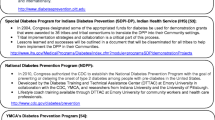Abstract
Background: The increasing incidence and prevalence of metabolic syndrome and type 2 diabetes mellitus (DM) have significant implications on health world-wide. Large clinical trials have demonstrated the effectiveness of a comprehensive lifestyle program with a goal of moderate weight loss (5–7%) and regular exercise (150 minutes/week), resulting in a significant decrease in the incidence of type 2 DM and cardiovascular risk.Methods: This study reports on the translation of the multi-center Diabetes Prevention Program (DPP) into a cardiac rehabilitation program, utilizing the expertise and experience of a cardiac rehabilitation program staff. The study adapted materials from the DPP to develop a program that fit local needs for diabetes prevention.Results: Most participants completed the program (11 months) and their moderate weight loss was maintained for 11–12 months. At 11–12 months, waist circumference was reduced by approximately 2 inches, percent body fat was reduced by 5% (11% relative decrease, p<.05), weight was decreased by 10.1 pounds (p<.05), and blood pressure was reduced 8/3 mm Hg (p<.05). Exercise, nutrition, glucose, triglycerides, LDL-cholesterol and HDLcholesterol were all were significantly improved at 11–12 months (p<.05).Conclusions: Efforts to improve lifestyle and reduce body weight are important to patients at risk of developing diabetes. This program demonstrates that an intensive effort can significantly improve lifestyle and reduce body weight in patients with DM or at risk for DM. A program that simulates cardiac rehabilitation, translated from a successful clinical trial into practice, resulted in significant reduction and improvement in metabolic outcomes and cardiovascular risk. Support for cardiac rehabilitation from insurers to develop similar programs is encouraged and deserves further study.
Similar content being viewed by others
References
Tuomilehto J, Lindstrom J, Eriksson JG, et al. Prevention of type 2 diabetes mellitus by changes in lifestyle among subjects with impaired glucose tolerance. N Engl J Med 2001;344:1343–50.
Reduction in the incidence of type 2 diabetes mellitus with lifestyle intervention or metformin. N Engl J Med 2002:346:393–403 [website: http://www.bsc.gwu.edu/ dpp/index.htmlvdoc]
Centers for Disease Control Fact Sheet on Diabetes website: http://www.cdc.gov/diabetes/pubs/estimates05.htm
National Cholesterol Education Program Adult Treatment Panel III. Executive summary of the third report of the National Cholesterol Education Program (NCEP) expert panel on detection, evaluation, and treatment of high blood cholesterol in adults (Adult Treatment Panel III). JAMA 2001;285(19):2486–2497.
Lavie CJ, Milani RV. Cardiac rehabilitation and exercise training programs in metabolic syndrome and diabetes. Journal of Cardiopulmonary Rehabilitation 1005;25:59–66.
Herman, William H. et al. The Cost-Effectiveness of Lifestyle Modification or Metformin in Preventing Type 2 Diabetes in Adults with Impaired Glucose Tolerance. Annals of Internal Medicine. 2005;142:323–332.
Ackermann, Ronald T. et al. An Evaluation of Cost Sharing to Finance a Diet and Physical Activity Intervention to Prevent Diabetes. Diabetes Care. 2006;29:1237–1241.
Spitzer R, Kroenke K, Williams J. Validation and utility of a self-report version of PRIME-MD: the PHQ Primary Care Study. Journal of the American Medical Association 1999;282:1737–1744. (survey available at: http://www.depressionprimarycare. org/clinicians/toolkits/materials/forms/phq9/)
The American Dietetic Association’s Complete Food and Nutrition Guide, 1998. Are You Ready to Lose Weight?
Booth, M.L. Assessment of Physical Activity: An International Perspective. Research Quarterly for Exercise and Sport, 2000:71 (2): s114-s120.
Gardner CD, Kiazand A, Slhassan S, et al. Comparison of the Atkins, Zone, Ornish, and LEARN diets for change in weight and related factors among overweight premenopausal women: The A to Z Weight Loss Study: A randomized trial. JAMA 2007;297:969–977.
Author information
Authors and Affiliations
Corresponding author
Rights and permissions
About this article
Cite this article
McBride, P.E., Einerson, J.A., Grant, H. et al. Putting the diabetes prevention program into practice: A program for weight loss and cardiovascular risk reduction for patients with metabolic syndrome or type 2 diabetes mellitus. J Nutr Health Aging 12, 745–750 (2008). https://doi.org/10.1007/BF03028624
Received:
Accepted:
Issue Date:
DOI: https://doi.org/10.1007/BF03028624




